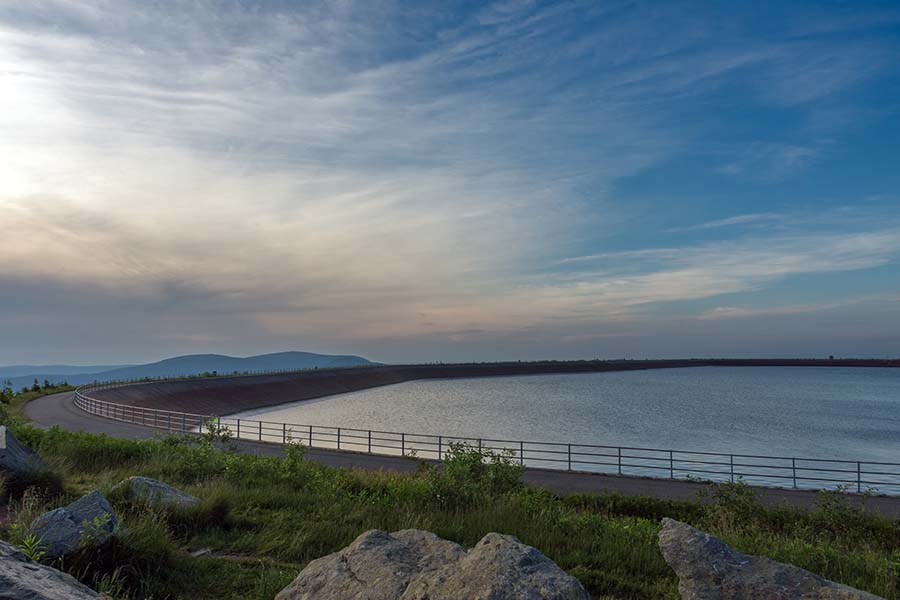Welcome to our guide for using RPE liners in PSH reservoirs! You’re the design engineer, the geotechnical expert, or the contractor on a new Pumped Storage Hydropower project. You’ve got the big picture covered—the dam, the turbines, the grid connection. We’re liner experts, and this guide is our contribution to the project: a practical, hands-on look at specifying and installing RPE geomembrane systems for these unique reservoirs.
There’s no prescriptive government code for lining a PSH reservoir, so the responsibility falls to the project team to engineer a solution that works. That solution needs to be built on a modern, high-performance material.
This guide focuses on Reinforced Polyethylene (RPE) as the superior liner material. It’s a tougher, more flexible material that solves a lot of the headaches that come with a PSH project. The big, factory-made panels make field installation a whole lot faster and safer, and the material itself is built to withstand the daily beating of a fill-and-drain cycle without breaking down.
Let’s walk through the whole process —from material specs and laying the groundwork to the design details, the actual install, and long-term care. Let’s get started.
The PSH Renaissance and the Knowledge Gap
The demand for new Pumped Storage Hydropower facilities is surging. Driven by the need for grid-scale storage to support renewable energy and encouraged by new federal incentives, a new wave of PSH development is underway for the first time in nearly 40 years.
This creates a unique professional challenge. The last significant build-out of PSH in the U.S. ended in the early 1980s. Most of the engineers and contractors who led those projects have retired, taking decades of practical, hands-on experience with them. As a result, today’s PSH project teams are often working with a significant institutional “knowledge gap.” The standards and techniques from the last generation are outdated, and the expertise in modern methods is not yet widespread. Our intention is to help bridge that gap, providing a clear framework grounded in the latest materials science and installation practices.
Key Engineering Shifts Since the Last Generation
The engineering landscape for reservoir construction has fundamentally changed since 1980. The modern approach is defined by a shift from brute-force methods to more sophisticated, systems-based engineering. Understanding these key shifts is crucial for any project team.
From Mass to Performance
The old approach relied on mass and thickness for impermeability—typically a foot or more of reinforced concrete or dense asphalt. The modern approach relies on engineered performance. An advanced composite material, such as a 45-mil RPE liner (less than 1/16th of an inch thick), can provide superior puncture, tensile, and flexibility properties at a tiny fraction of the weight of older materials. This shift has massive engineering implications: it reduces the load on the subgrade, dramatically cutting material and transportation costs, and speeds up construction on complex geometries.
From Passive Tubs to Active Systems
A 1970s reservoir was essentially a passive concrete “bathtub.” Once it was built, its integrity was a black box—you only knew you had a problem when you saw a wet spot on the outside of the dam. In contrast, a 21st-century lining is an active, multi-layered system. By integrating layered components such as a GCL secondary liner and a geonet leak detection layer, the system provides built-in redundancy and real-time performance data. Leak detection recasts the liner from a basic barrier into an asset that continuously verifies containment integrity.
From Field Labor to Factory Precision
Traditional lining methods were distressingly dependent on the skill of the on-site crew and the mercy of the weather. Modern geosynthetics, particularly RPE, shift the most critical work to a controlled factory environment. Instead of thousands of feet of manual field welding, massive, multi-acre panels of RPE can be expertly welded in a clean, dry, quality-controlled facility. This dramatically reduces on-site labor and weather-related delays. Ultimately, its most crucial engineering benefit is a massive increase in the quality and reliability of the seams, which are the most likely failure point in any liner system.
This guide is organized to familiarize you with this modern approach, from the material up. We’ll start with the material specifications for RPE, build the system from the subgrade up, address PSH-specific design challenges, and then cover best practices for installation, quality control, and long-term care.




